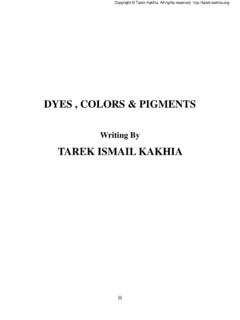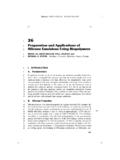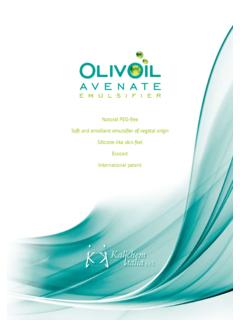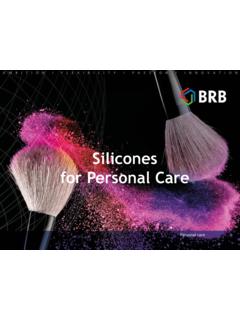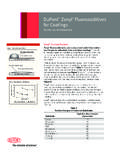Transcription of I - Antifoaming Agents
1 1 Contents : Subjects Page I Antifoaming Agents 1 II What is the Foam ? 2 III What is the Defoame r ? 9 IV Poly Propyle ne Glycol 15 V Turke y Re d Oil 18 I - Antifoaming Agents I Introduction : List of Important Material Wish Uses As Antifoaming Agents : * Alkyl poly acrylates * Castor Oil * Fatty Acids , * Fatty Acids Esters , * Fatty Acids Sulfate , * Fatty Alcohol , * Fatty Alcohol Esters , * Fatty Alcohol Sulfate , * Foot Olive Oil * Mono & Di Glyceride * Paraffin Oil , * Paraffin Wax , * Poly Propylene Glycol , * Silicones Oil , * Vegetable & Animal Fats , * Vegetable & Animal Fats Sulfate , * Vegetable & Animal Oil , * Vegetable & Animal Oil Sulfate , * Vegetable & Animal Wax , * Vegetable & Animal Wax Sulfate , Copyright Tarek Kakhia.
2 All rights reserved. What is the Foam ? Soap foam bubbles Contents 1 Introduction 2 Structure of foams 3 Foaming and foam stability 4 Experiments and characterizations 5 Applications Liquid foams Solid foams Syntactic foam Integral skin foam 6 De foaming 1 - Introduction : A foam is a substance that is formed by trapping pockets of gas in a liquid or solid. A bath sponge and the head on a glass of beer are examples of foams. In most foams, the volume of gas is large, with thin films of liquid or solid separating the regions of gas. An important division of solid foams is into closed-cell foams and open-cell foams.
3 In a closed-cell foam, the gas forms discrete pockets, each completely surrounded by the solid material. In an open-cell foam, the gas pockets connect with each other. A bath sponge is an example of an open-cell foam: water can easily flow through the entire structure, displacing the air. A camping mat is an Copyright Tarek Kakhia. All rights reserved. example of a closed-cell foam: the gas pockets are sealed from each other, and so the mat cannot soak up water. Foams are examples of dispersed media. In general, gas is present in large amount so it will be divided in gas bubbles of many different sizes (the material is poly disperse) separated by liquid regions which may form films, thinner and thinner when the liquid phase is drained out of the system films.
4 When the principal scale is small, for a very fine foam, this dispersed medium can be considered as a type of colloid. 2 - Structure of foams Cappuccinos are topped with a layer of steamed-milk foam. A foam is in many cases a multi scale system. One scale is the bubble one: real-life foams are typically disordered and have a variety of bubble sizes. At larger sizes, the study of idealized foams is closely linked to the mathematical problems of minimal surfaces and three-dimensional tessellations, also called honeycombs. The Weaire - Phelan structure is believed to be the best possible (optimal) unit cell of a perfectly ordered foam , while Plateau's laws describe how soap-films form structures in foams.
5 At lower scale than the bubble one, is the thickness of the film for dry enough foams, which can be considered as a network of interconnected films called lamellae. Ideally, the lamellae are connected by three and radiate 120 outward from the connection points, known as Plateau borders. An even lower scale is the one of the liquid-air interface at the surface of the film. Most of the time this Copyright Tarek Kakhia. All rights reserved. interface is stabilized by a layer of amphiphilic structure, often made of surfactants, particles (Pickering emulsion), or more complex associations.
6 3 - Foaming and foam stability Several conditions are needed to produce foam: there must be mechanical work, surface active components (surfactants) that reduce the surface tension, and the formation of foam faster than its breakdown. To create foam, work (W) is needed to increase the surface area ( A): where is the surface tension. Stabilization of foam is caused by van der Waals forces between the molecules in the foam, electrical double layers created by dipolar surfactants, and the Marangoni effect, which acts as a restoring force to the lamellas. Several destabilizing effects can break foam down : (i) Gravitation causes drainage of liquid to the foam base, (ii) Osmotic pressure causes drainage from the lamellas to the Plateau borders due to internal concentration differences in the foam, while (iii) Laplace pressure causes diffusion of gas from small to large bubbles due to pressure difference.
7 Films can break under disjoining pressure, These effects can lead to rearrangement of the foam structure at scales larger than the bubbles, which may be individual (T1 process) or collective (even of the "avalanche" type). 4 - Expe riments and characterizations Being a multi scale system involving many phenomena, and a versatile medium, foam can be studied using many different techniques. Considering the different scales, experimental techniques are diffraction ones, mainly light scattering techniques (DWS, see below, static and dynamic light scattering, X rays and neutron scattering) at submicronic scales, or microscopic ones.
8 Considering Copyright Tarek Kakhia. All rights reserved. the system as continuous, its bulk properties can be characterized by light transmittance but also conductimetry. The correlation between structure and bulk is evidenced more accurately by acoustics in particular. The organization between bubbles has been studied numerically using sequential attempts of evolution of the minimum surface energy either at random (Pott's model) or deterministic way (surface evolver). The evolution with time, the dynamics, can be simulated using these models, but also the bubble model (Durian) which considers the motion of individual bubbles.
9 Among possible examples, low scale observations of the structure done using reflectivity by the films between bubbles, of radiation, ponctual using laser or X rays beams, or more global using neutron scattering. A typical light scattering (or diffusion) optical technique is multiple light scattering coupled with vertical scanning is the most widely used technique to monitor the dispersion state of a product, hence identifying and quantifying destabilization phenomena.[2][3][4][5] It works on any concentrated dispersions without dilution, including foams. When light is sent through the sample, it is backscattered by the bubbles.
10 The backscattering intensity is directly proportional to the size and volume fraction of the dispersed phase. Therefore, local changes in concentration (drainage, syneresis) and global changes in size (ripening, coalescence) are detected and monitored. 5 - Applications 5 1 - Liquid foams Liquid foams can be used in fire retardant foam, such as those that are used in extinguishing fires, especially oil fires. In some ways, leavened bread is a foam, as the yeast causes the bread to rise by producing tiny bubbles of gas in the dough. Ideally, the dough is a closed-cell foam, in which the gas pockets do not connect with each other.
